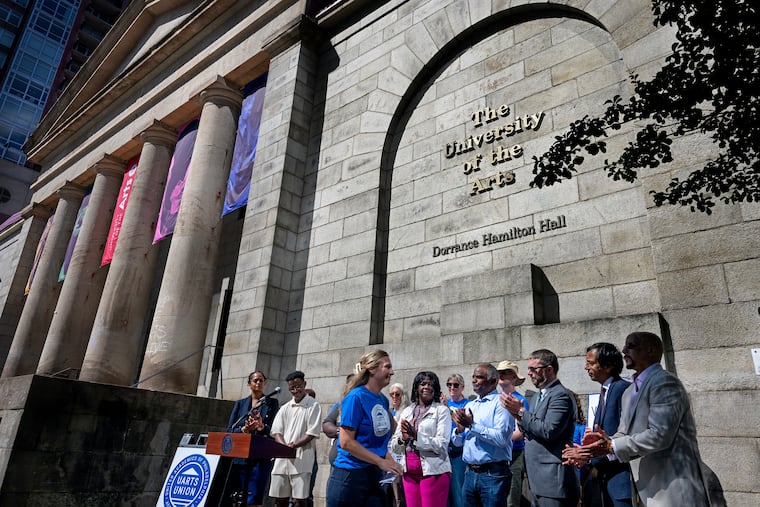Bids are sought on nine UArts properties
“There is at least one building that we would have a significant interest in,” said Temple University president John A. Fry.

As the University of the Arts’ bankruptcy proceeds, Dec. 11 has been set as the day for potential buyers to submit bids on its prime Center City properties.
Temple University and Philadelphia developer Carl Dranoff, who has built residential buildings on South Broad Street for decades, are among the potentially interested buyers of one or more of the nine buildings.
There has been significant interest in the properties, with every building receiving at least some attention from buyers, according to a source close to the process who was not authorized to speak to the media and asked not to be named. There have been 40 tours so far, with more scheduled.
» READ MORE: University of the Arts real estate sales are moving forward as a company has been hired to sell 9 buildings
“There is at least one building that we would have a significant interest in,” said Temple University president John A. Fry.
He declined to identify the building, given the forthcoming bidding process, which could take several months.
The 150-year-old arts college abruptly announced its closure in June, giving only one week’s notice to students, faculty, and staff. The closure stunned the local higher education community, leading to lawsuits and protests and leaving many questions unanswered. The future sale of its buildings likely will lead to the end of UArts’ physical presence in Philadelphia.
» READ MORE: UArts has filed for Chapter 7 bankruptcy to liquidate its assets
Temple attempted to negotiate an acquisition of the school after its closure, but when that deal fell apart, the bankruptcy process was initiated.
“The nine-property campus provides the opportunity to reshape the heart of Philadelphia’s Central Business District,” said an announcement from JLL, a real estate services company that has been hired to sell the property. “The campus can be redeveloped for a range of uses including multi-family, office, retail, hospitality, healthcare, classroom, and entertainment.”
» READ MORE: Carl Dranoff plans 176 more apartments on South Broad
Collectively, the buildings, five of which JLL described as having historic designations and offer financial incentives in tax credits for future owners, occupy 760,000 square feet. They are: Arts Bank, 601 S. Broad St.; Anderson Hall, 329-333 S. Broad St.; Hamilton Hall, 320 S. Broad St.; Furness Hall, 1499 Pine St./320R S. Broad St.; Juniper Hall, 311 S. Juniper St.; Gershman Hall, 401 S. Broad St.; Arts Alliance, 251 S. 18th St.; Spruce Hall, 1228 Spruce St.; and Terra Hall, 201-211 S. Broad St., which is the biggest at 274,000 square feet.
They housed offices, classrooms, libraries, residence halls, performance spaces, and galleries. Most of them are on South Broad Street between City Hall and South Street.
Bidders have been asked to include, among other details, their proposed purchase price and their source of funds or equity partners for the acquisition. They can bid on the properties individually, as part of a package, or as a whole group. Some are interested in repurposing the buildings for hospitality or residential purposes, while others likely will continue with an educational or not-for-profit use, according to the source.
Fry said Temple has done a careful evaluation of the buildings to determine the amount of deferred maintenance and investment needed. That evaluation actually began when Temple was in talks about a possible acquisition of UArts. But those talks fell apart after the Hamilton Family Charitable Trust, which has contributed about half of UArts’ $63 million endowment, said it did not favor having the endowment go to Temple as part of the deal.
UArts subsequently asked a Philadelphia judge in Orphans’ Court to approve the distribution of the endowment to a dozen colleges, including Temple, that enrolled its students. The case is ongoing.
Fry noted that Temple already leases a Center City site but said the school would like to have a more visible presence.
“We are looking to add at least one of the UArts buildings, perhaps, to be a future home for Temple University Center City, but we haven’t made a final decision about whether or not we are going to invest,” Fry said “But it appears that there is one building that would be suitable for our needs down the road.”
A spokesperson for Dranoff Properties said: “He’s looked at the properties and is considering it.”
Other groups were mum about whether they may pursue any of the properties. A spokesperson for the Curtis Institute of Music, a private conservatory on Locust Street, said she could not comment. Neither would a representative for Lubert-Adler, a Philadelphia-based real estate company known for rehabbing historic buildings, including the iconic Bellevue on South Broad Street.
Others, including Alterra Property Group and Post Bros., said they were not interested.